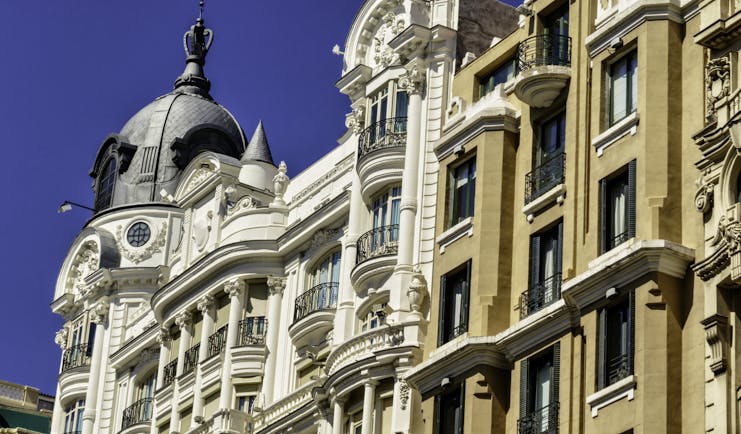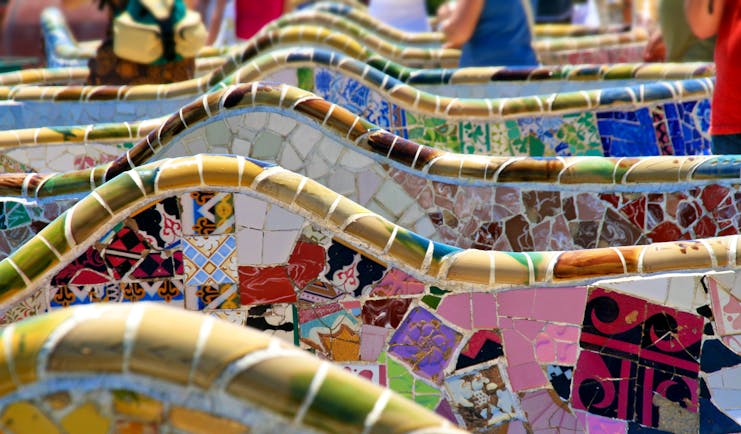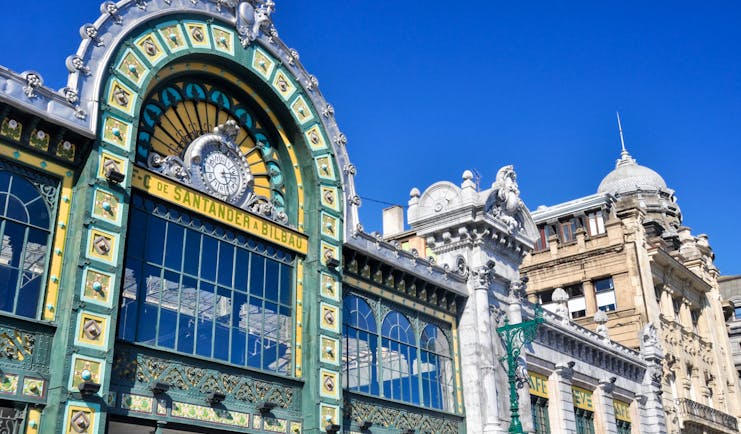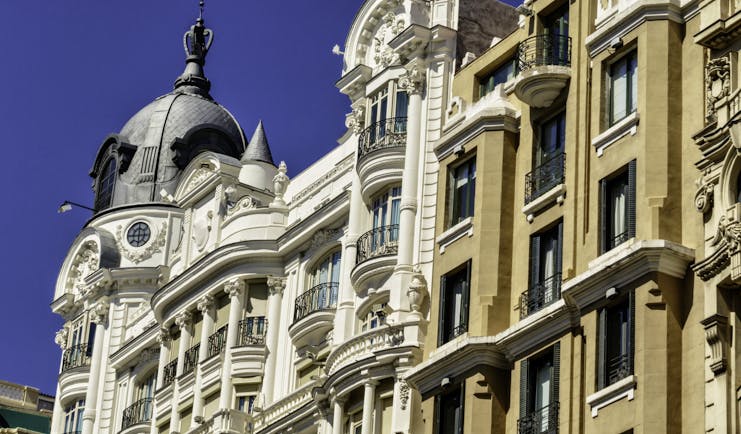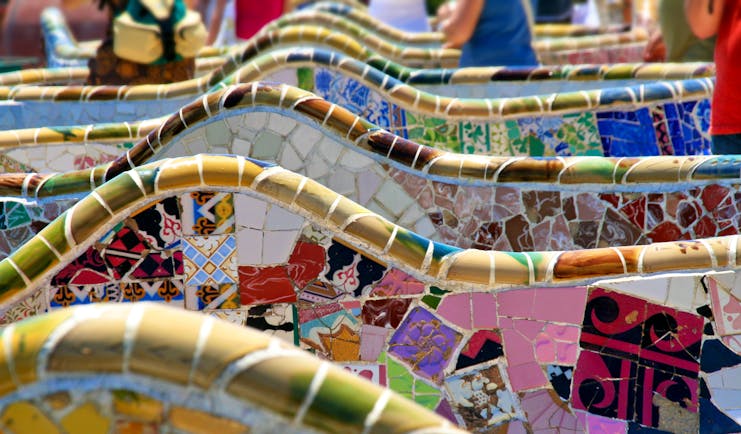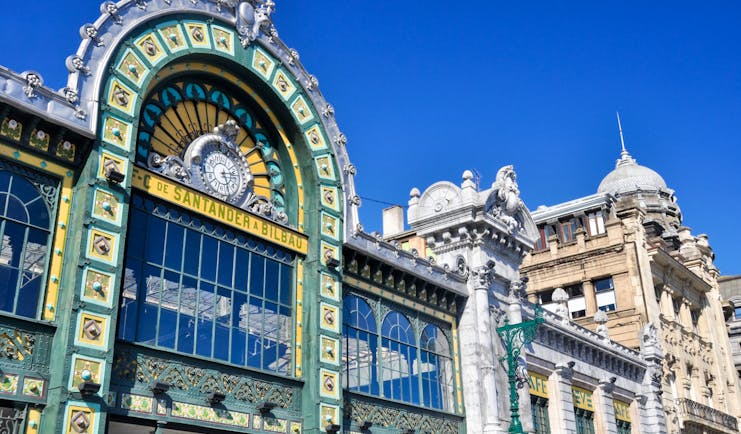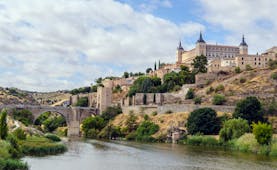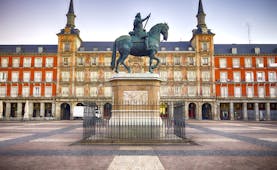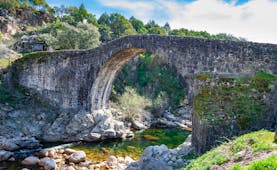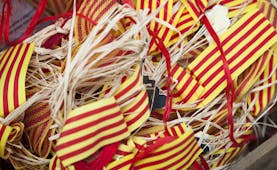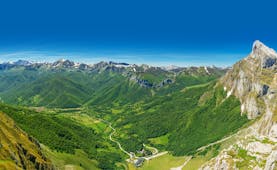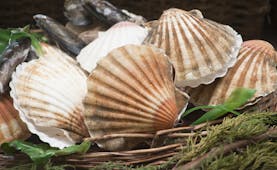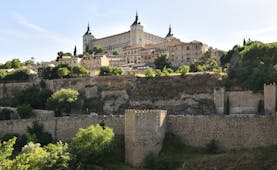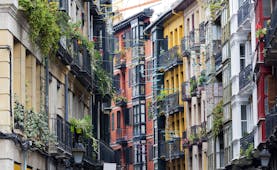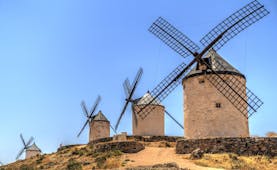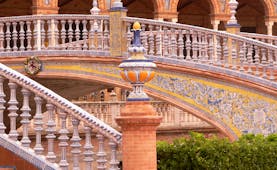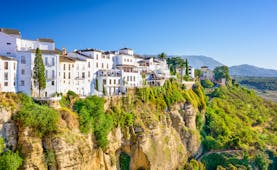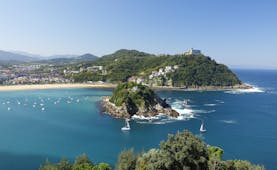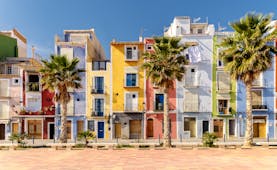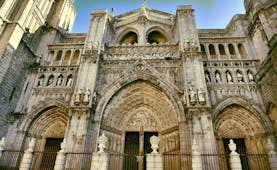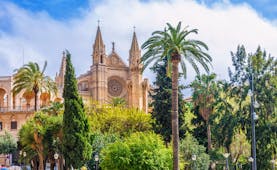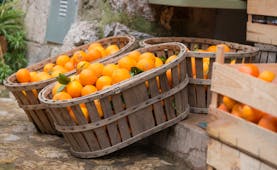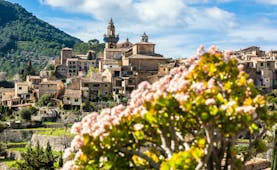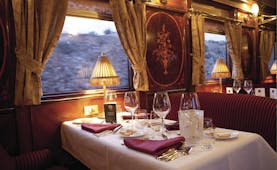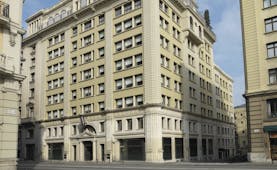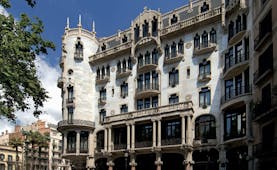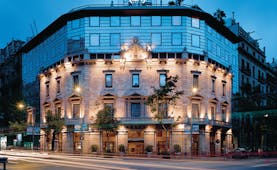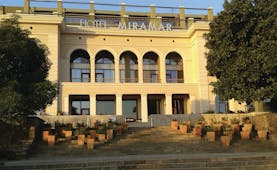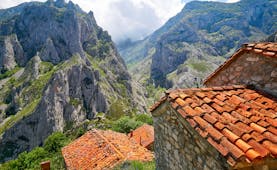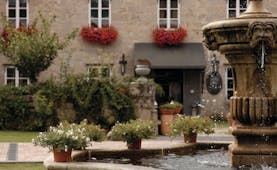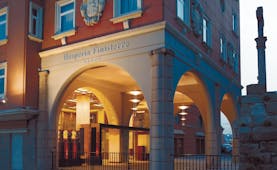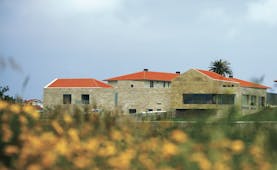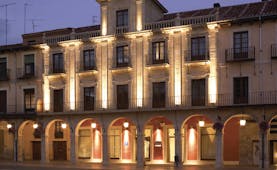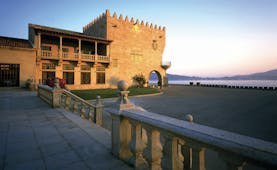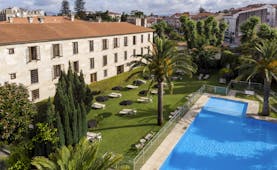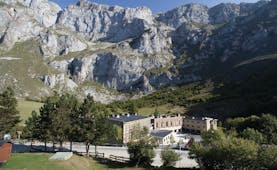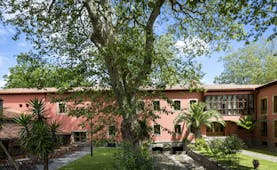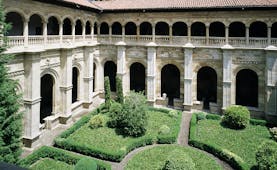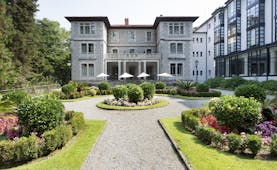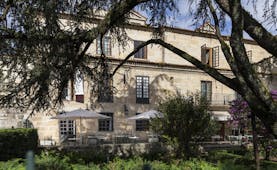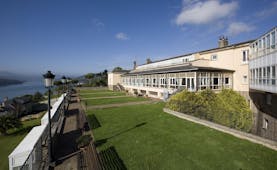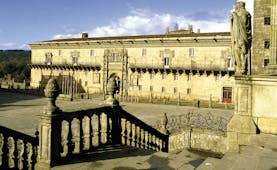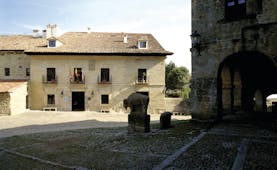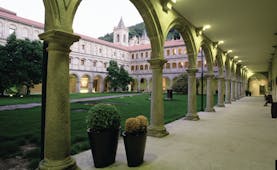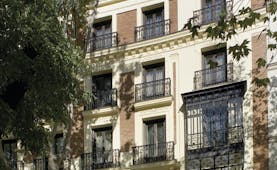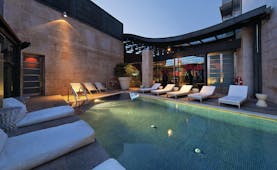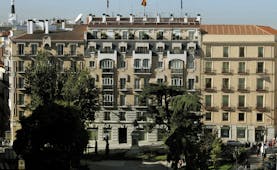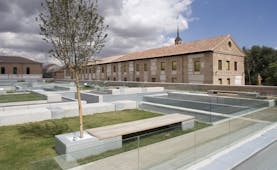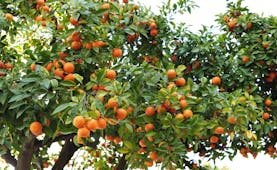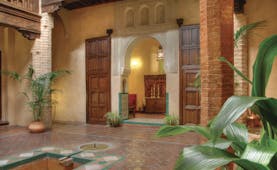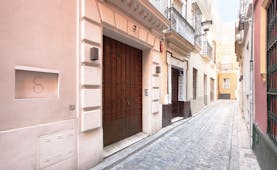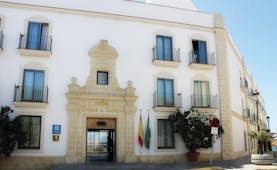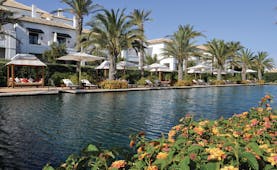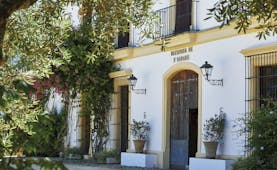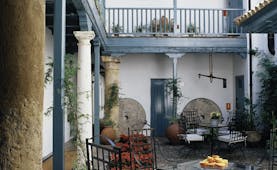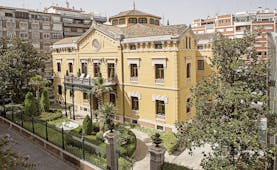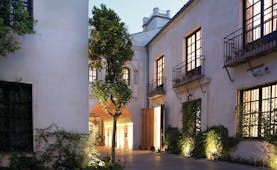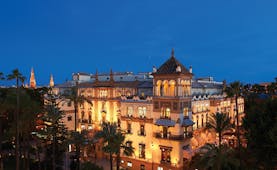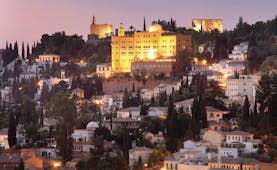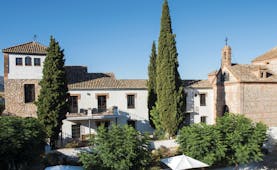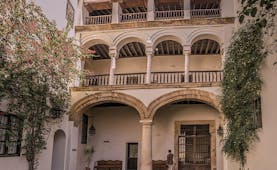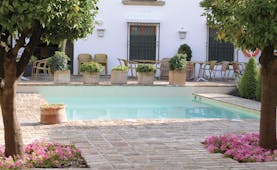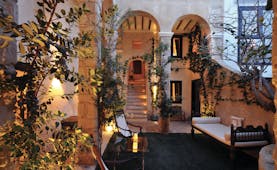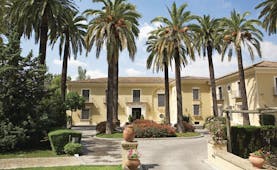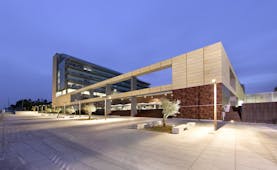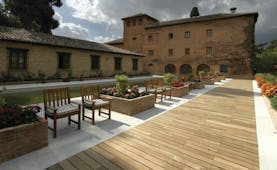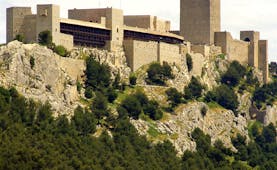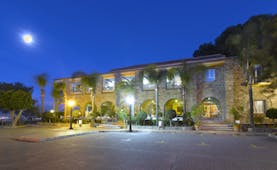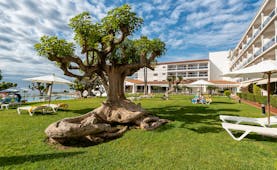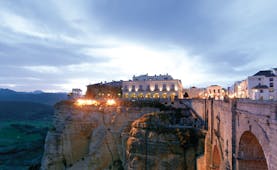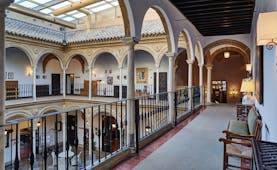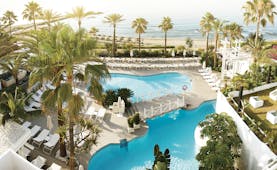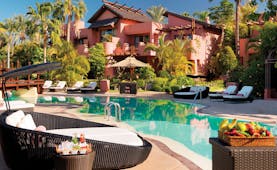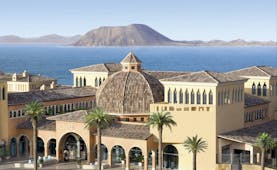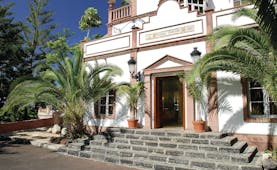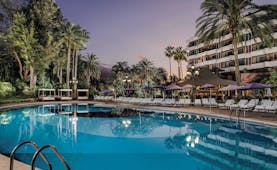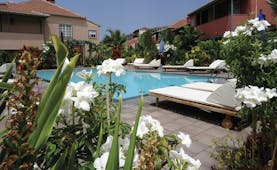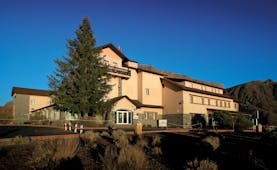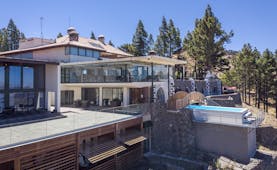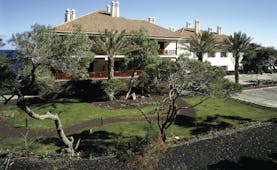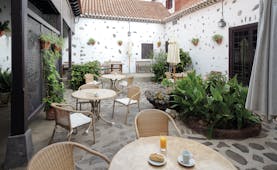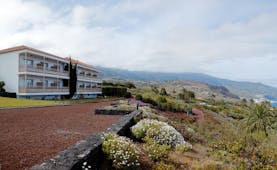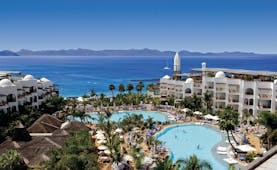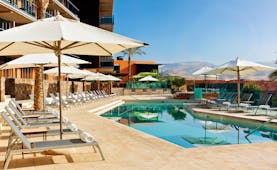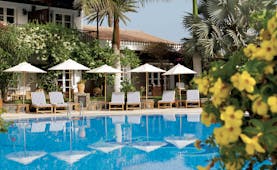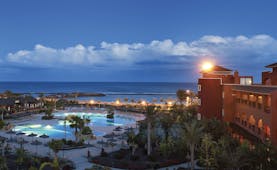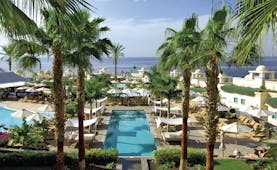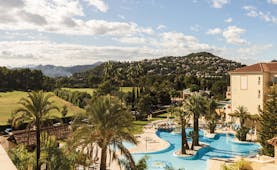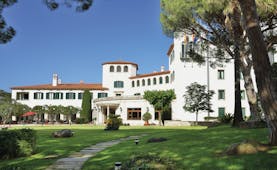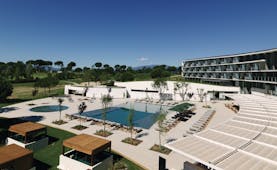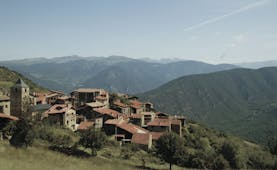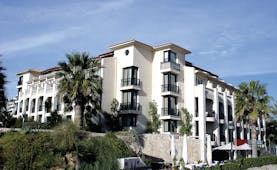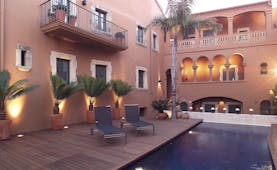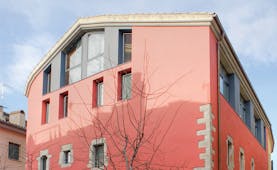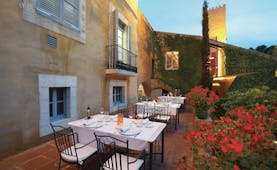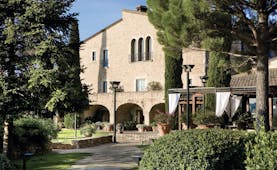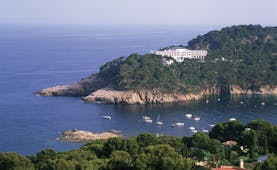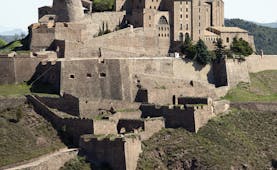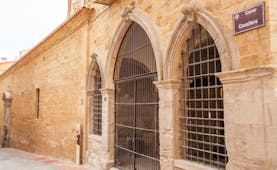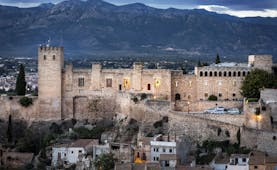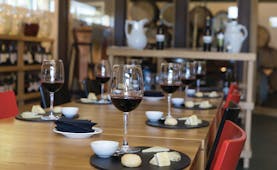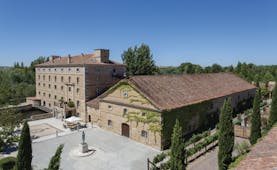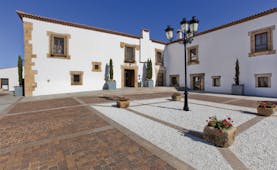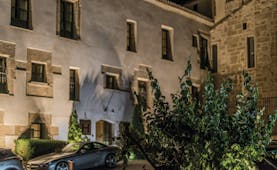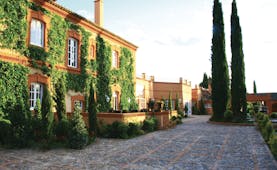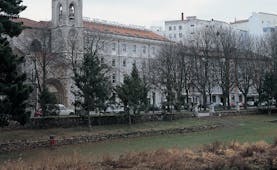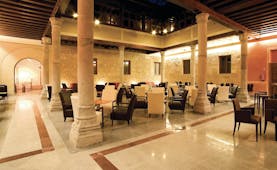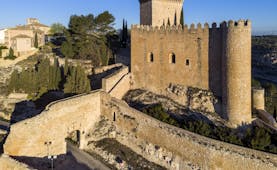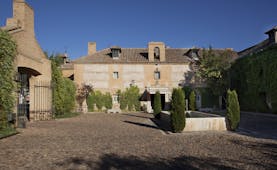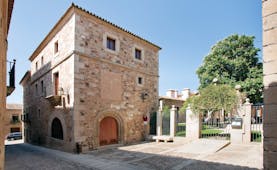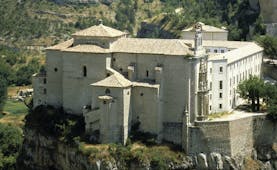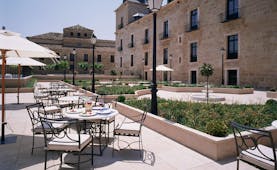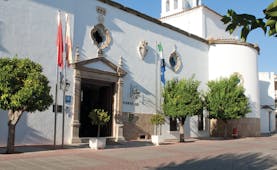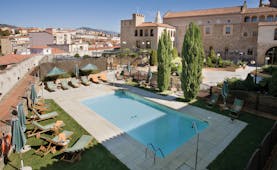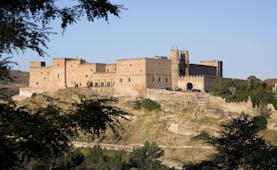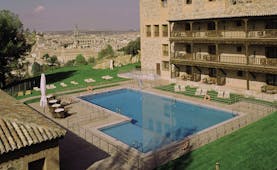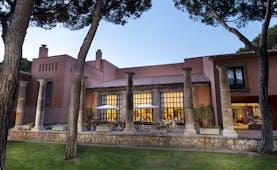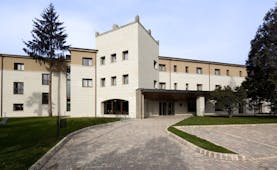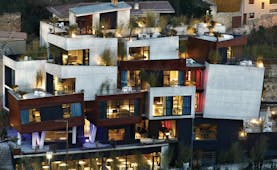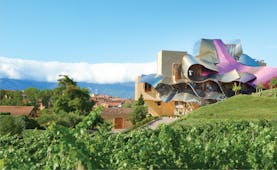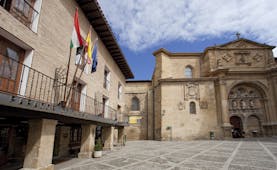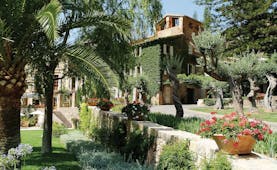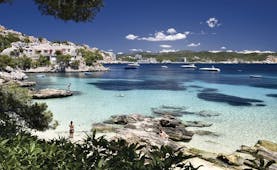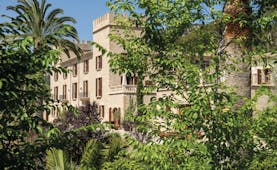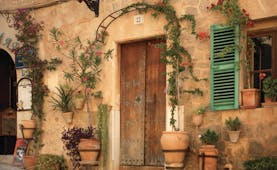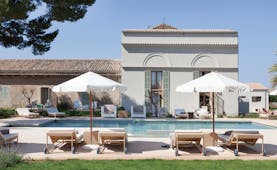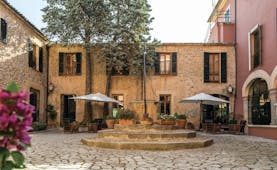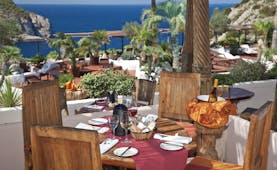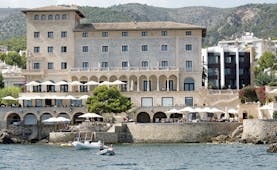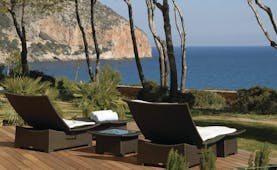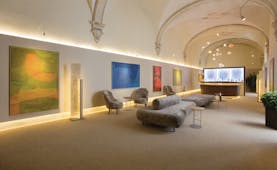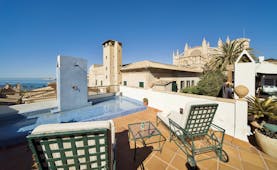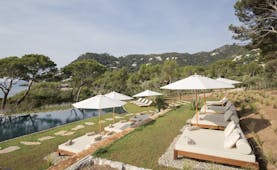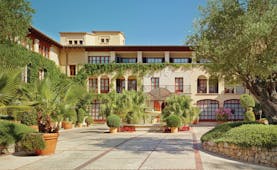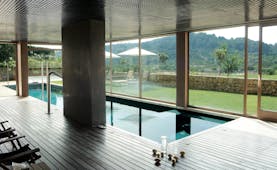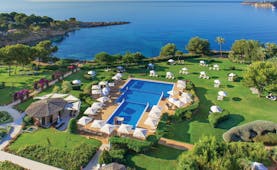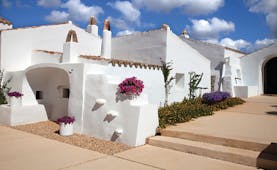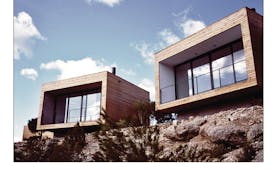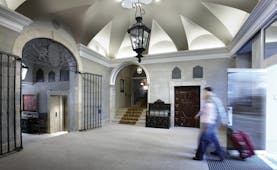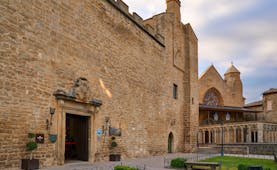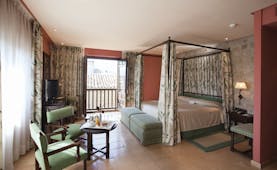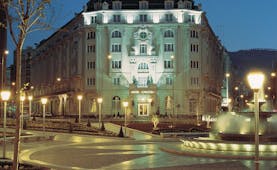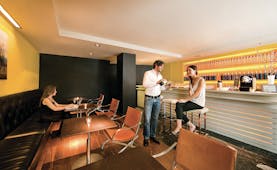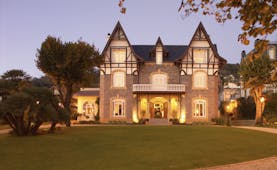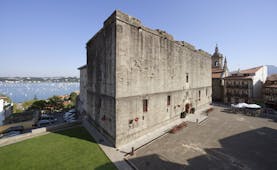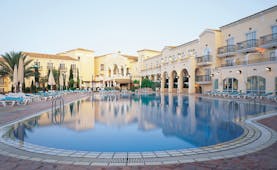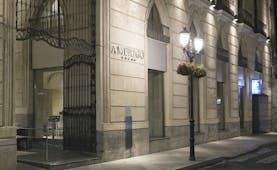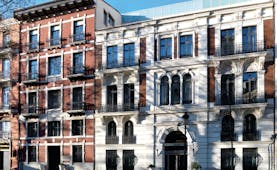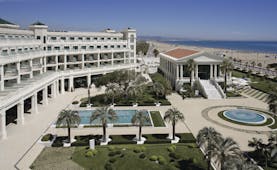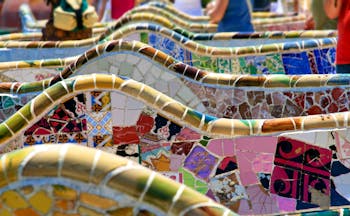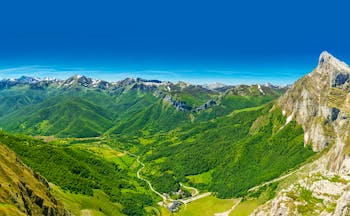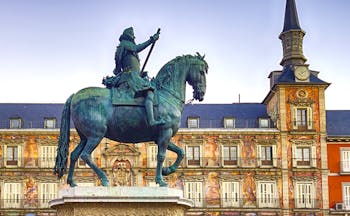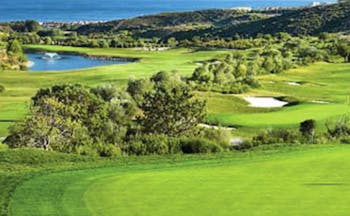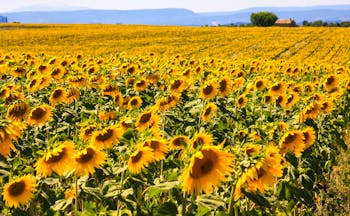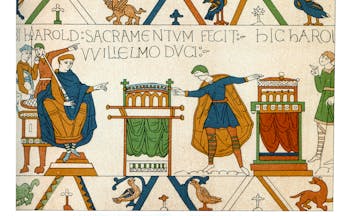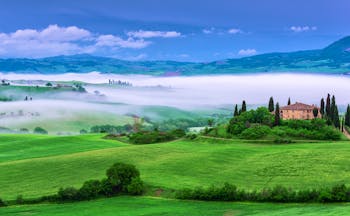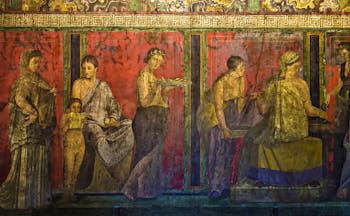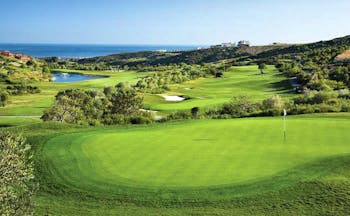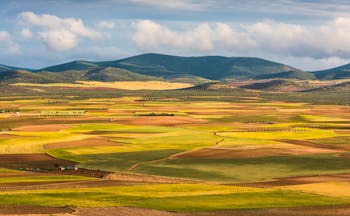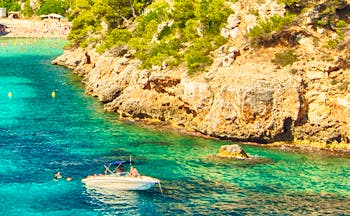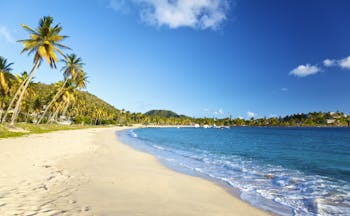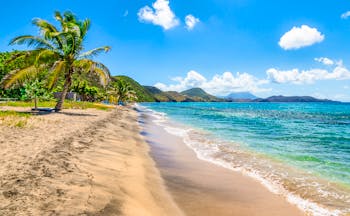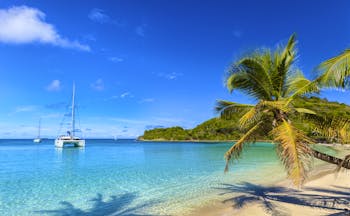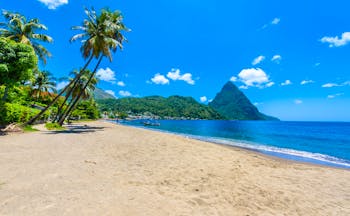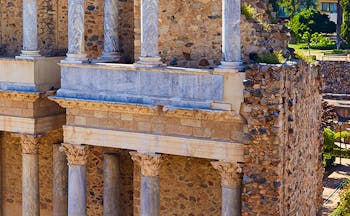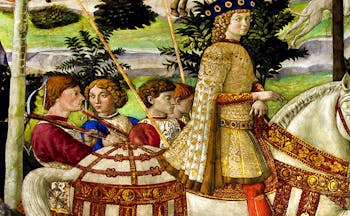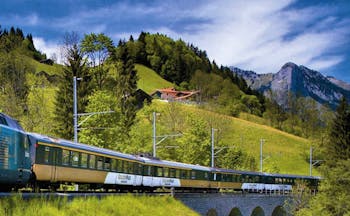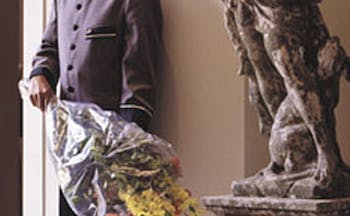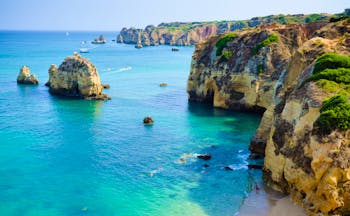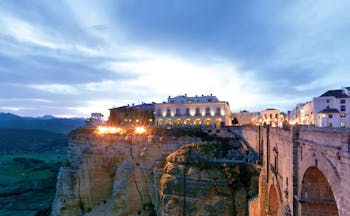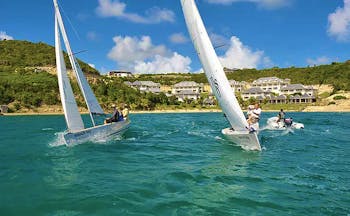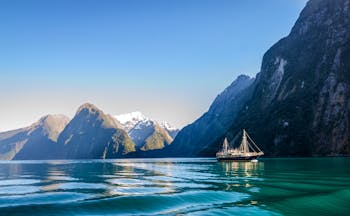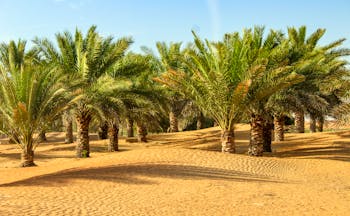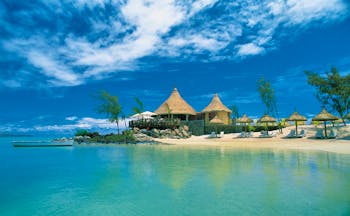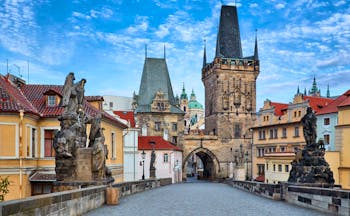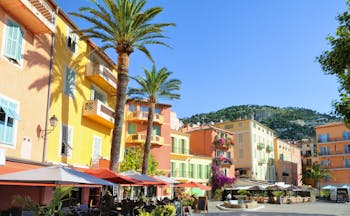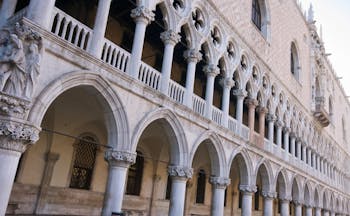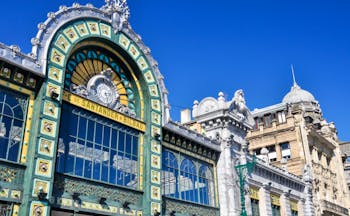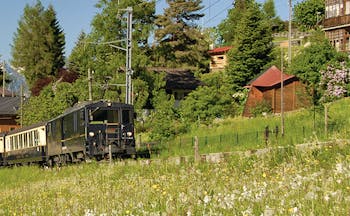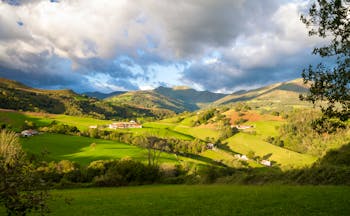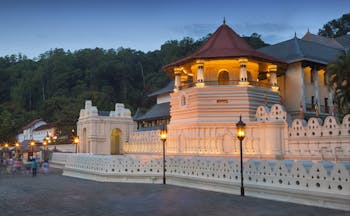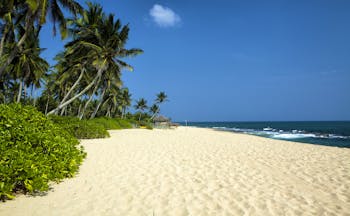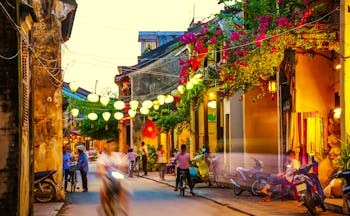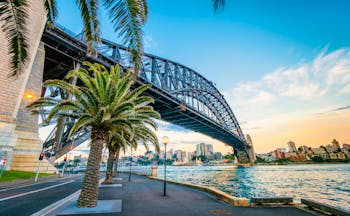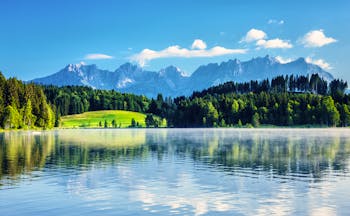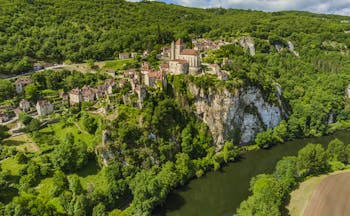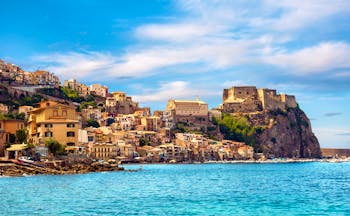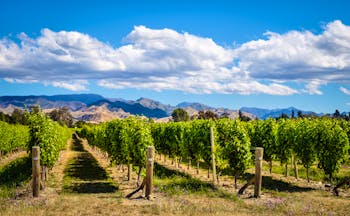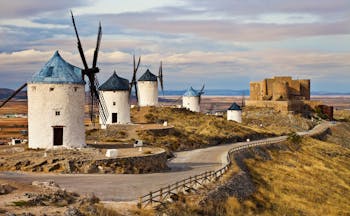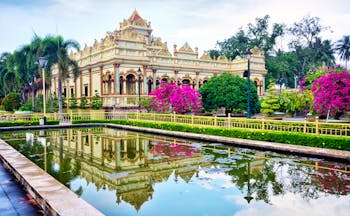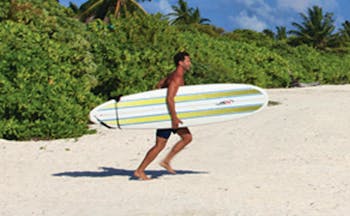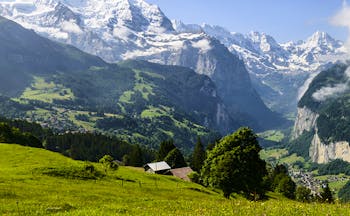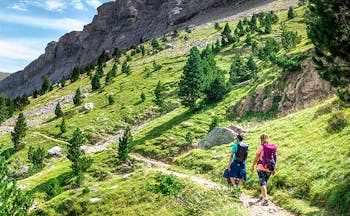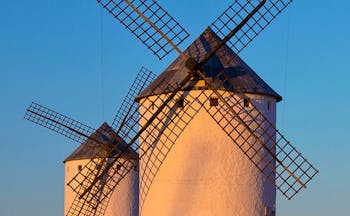Luxury touring holiday of Spain exploring Spanish art and architecture in the three cultural cities of Madrid, Bilbao and Barcelona
This 8-night touring holiday of Spanish art and architecture by air and train begins with your arrival in Madrid. Catch a train as soon as you arrive and travel north to Bilbao in the Basque Country. Spend two nights at the Hotel Carlton, a property that seamlessly blends Bilbao’s traditional Spanish heritage with the touches of contemporary design that reflect its glamorous neighbour: the Guggenheim Museum. During the day, explore the collections and exhibitions housed within this striking building, enjoy the other attractions, and seek out Bilbao’s most charming architecture. Then, catch a train across northern Spain and into Catalonia, for three nights at the Hotel Claris in Barcelona. Begin by exploring the modernista style, established by Antoni Gaudi and his contemporaries, which informed the design of your hotel. Perhaps start with the iconic Sagrada Familia, before walking down the Passeig de Grácia and venturing into the Zona Alta to see the Parc Guell. Also take the time to visit the maze-like Gothic quarter, Montjuïc Castle, and the old merchant palaces of La Ribera. To reach your final stop on this tour, catch a high-speed train back to the capital of Spain, Madrid. Stay for three nights at the Hotel Urban, a property that lives up to its name in both its impeccable design and its excellent location, exploring the three world-class art museums that form a triangle around the city’s centre. On your final full day in Spain, visit two Royal residences and take in the lively atmosphere of this bustling city. Then, at the end of this fascinating touring holiday return to London from Madrid by air.
Highlights
Bilbao • Plaza de Don Federico Moyúa • Guggenheim Museum • Barcelona • Sagrada Familia • Casa Batllo • Madrid • Palacio Real de Madrid • Toledo • Segovia • El Escorial
Day by day
Start your touring holiday by flying into Madrid before catching an afternoon train northwards to Bilbao, arriving in the late evening. Travel to your hotel, the five-star Hotel Carlton, which enjoys a privileged position a few steps from the Plaza de Don Federico Moyúa and a short distance from the iconic Guggenheim Museum. Stay for two nights in either a room decorated in chic, contemporary colours, or a room designed with a more traditional Spain in mind. On your first evening, either dine in the elegant dining room, or seek out one of the many excellent restaurants in the city to try some of the hearty local gastronomy. Spend two nights in Bilbao.
You have a whole day to feast on the artistic and architectural wonders of this vibrant city, perhaps starting off with a visit to the Guggenheim Museum. Designed by Frank Gehry, this futuristic building, with its shimmering curves of titanium and glass, is home to a permanent collection of contemporary art and regularly hosts temporary exhibitions. Only a few minutes’ walk away from the hotel is the Bilbao Fine Arts Museum, which houses an extensive collection ranging from 12th Century sculptures to 20th Century paintings. Not only will visitors find a number of works by Basque artists, they will see works by renowned artists including El Greco, Goya and Gaugin. To witness some of Bilbao’s more traditional architecture, we would recommend entering Bilbao’s old quarter through the Plaza Circular, kicking back on the grand Plaza Nueva, with its pavement cafes and weekly market, and finding the beautiful Teatro Arriaga, with its curved façade, statuettes, and ornate stonework. The Church of Saint Anthony the Great and the Basilica of Begoña offer an insight into the religious architecture of the city, and both have radiantly lit interior chambers, and very traditional layouts and towers. Around 20 miles east of Bilbao is the town of Guernica, the namesake of Picasso’s famous painting which was inspired by the town’s bombing during the Spanish Civil War, which makes for an excellent excursion by bus or train. As the sun sets, wander down the Gran Vía de Don Diego López de Haro to soak up the lively street entertainment, dip in and out of the shops, and enjoy the cosmopolitan side to Spain.
Spend the morning exploring anything you might have missed in Bilbao, before you take a mid-afternoon train to Barcelona, arriving in the Catalan capital just after 10pm. Here you will stay for three nights at Hotel Casa Fuster, itself a remarkable building which has been designed in the eclectic and vibrant ‘Modernista’ style that is typical of Barcelona. Spend two days in Barcelona. The Hotel Claris is a stylish hotel located in central Barcelona, just a short walk from Passeig de Gracia and two of Antoni Gaudi's more famous buildings, La Pedrera and Casa Battlo. Spend three nights in Barcelona.
Use the two full days in Barcelona to explore the many sights. The most famous landmark of this beautiful city is the Sagrada Familia, an unconventional church building which is filled with symbolism and fulfilled Gaudi’s dream of combining religious reverence with a dramatically sculpted skyline. The other famous works of art that feature Gaudí’s trademark curved lines, decorated chimneys, elaborate wrought iron, and mosaic decorations include Parc Guell in the Zona Alta, the more Gothic Palau Guell, and Casa Batlló and La Pedrera on the Passeig de Gràcia. There are also a number of outstanding art museums within the city, including the Picasso Museum in the La Ribera quarter, housed in a converted merchant’s palace, which traces the life and works of Pablo Picasso, the Joan Miró Foundation dedicated to works by the eponymous Catalan painter, and the National Art Museum of Catalonia, which holds a vast collection of Catalan art from throughout the ages. The Gothic quarter, or Barri Gotic, is also home to outstanding architecture dating back to mediaeval times, including the cathedral, and Barcelona’s best shops. An easy day trip by train from Barcelona is to Figueres, a small city around 90 miles to the north, which is known for being the birthplace of Salvador Dalí. Figueres is home to the renowned Dalí Theatre-Museum, with its pink exterior walls, egg-shaped battlements, vast glass globe, and extensive collection of the artist’s works, as well as pieces by other artists such as El Greco. Also essential to any visit to Barcelona is a walk down La Rambla, stopping off at La Boqueria Market to sample the famous oysters, a few hours spent on one of the 6 Blue Flag beaches, known also for the restaurants that serve the best seafood in the city, and a visit to Montjuïc Castle, the tallest monument in the city. In the evenings, dine at the hotel or choose from one of the many excellent restaurants and tapas bars Barcelona has to offer.
From Barcelona, catch one of the hourly high-speed trains to Madrid, arriving around three hours later. Stay at the Hotel Urban, a five-star hotel in the cultural centre of the city. You spend three nights in Madrid.
Your two days in Madrid will be packed with prestigious art and architecture from throughout the centuries. The hotel is within walking distance of all three of the world-class art museums which make up Madrid’s Golden Triangle of Art. The Prado Museum is one of the largest art galleries in the world and contains an impressive selection of Spanish paintings, including works by Goya and El Greco; the Reina Sofia Museum is Spain’s premier collection of modern 20th and 21st century art including Picasso’s ‘Guernica,’ films by Luis Buñuel and Salvador Dalí, and an abundance of striking sculpture; and the Thyssen-Bornemisza Museum, one of the best private collections of 13th to 20th century art, illustrates the history of western art and includes pieces by Goya, Degas, Kandinsky and Renoir, but must be booked in advance. After visiting all three of these prestigious museums, enjoy the atmosphere of the capital. Take in the ambience of the Plaza Mayor, the grand arcaded square at the centre of the city. Then, visit the Palacio Real de Madrid, the official residence of the Royal family, which is often open for the public to explore. Inside, the highlights include the Spanish marble, stucco carvings, frescoes painted by Giaquinto, Tiepolo, and Bayeu, and the fully-equipped Royal Armoury. If you are not able to go inside, you can still enjoy the Plaza de Oriente beside the palace, which has statues of the Gothic Kings lining its central walkway, or the Campo del Moro Palace Gardens. The Basilica de San Francisco el Grande has atmospherically lit golden walls, and a blue and green painted dome that is recognised to be one of the best in Spain. Situated just outside the city, the historical residence of the King of Spain, El Escorial, is a vast palace complex with magnificent gardens that is also open to the public. However, you may need to arrange private transportation to reach it. Other, longer day trips include Toledo, the City of Three Cultures, and Segovia, home to the Alcázar that inspired Disney’s Cinderella Castle, and an long and well-preserved Roman aqueduct.
Perhaps spend a few hours at leisure in Madrid before you catch your return flight to the UK.
It has been a lovely holiday & once again, you did not disappoint. Thank you again for everything. We look forward to contacting you again for our next adventure.Mrs H, July 2025
Holiday price guide Prices from £2,640 per person based on two people sharing a double or twin room.
Holiday Code SNFR07
Call us on 01392 441245
Luxury touring holiday of Spain exploring Spanish art and architecture in the three cultural cities of Madrid, Bilbao and Barcelona
Start your touring holiday by flying into Madrid before catching an afternoon train northwards to Bilbao, arriving in the late evening. Travel to your hotel, the five-star Hotel Carlton, which enjoys a privileged position a few steps from the Plaza de Don Federico Moyúa and a short distance from the iconic Guggenheim Museum. Stay for two nights in either a room decorated in chic, contemporary colours, or a room designed with a more traditional Spain in mind. On your first evening, either dine in the elegant dining room, or seek out one of the many excellent restaurants in the city to try some of the hearty local gastronomy. Spend two nights in Bilbao.
You have a whole day to feast on the artistic and architectural wonders of this vibrant city, perhaps starting off with a visit to the Guggenheim Museum. Designed by Frank Gehry, this futuristic building, with its shimmering curves of titanium and glass, is home to a permanent collection of contemporary art and regularly hosts temporary exhibitions. Only a few minutes’ walk away from the hotel is the Bilbao Fine Arts Museum, which houses an extensive collection ranging from 12th Century sculptures to 20th Century paintings. Not only will visitors find a number of works by Basque artists, they will see works by renowned artists including El Greco, Goya and Gaugin. To witness some of Bilbao’s more traditional architecture, we would recommend entering Bilbao’s old quarter through the Plaza Circular, kicking back on the grand Plaza Nueva, with its pavement cafes and weekly market, and finding the beautiful Teatro Arriaga, with its curved façade, statuettes, and ornate stonework. The Church of Saint Anthony the Great and the Basilica of Begoña offer an insight into the religious architecture of the city, and both have radiantly lit interior chambers, and very traditional layouts and towers. Around 20 miles east of Bilbao is the town of Guernica, the namesake of Picasso’s famous painting which was inspired by the town’s bombing during the Spanish Civil War, which makes for an excellent excursion by bus or train. As the sun sets, wander down the Gran Vía de Don Diego López de Haro to soak up the lively street entertainment, dip in and out of the shops, and enjoy the cosmopolitan side to Spain.
Spend the morning exploring anything you might have missed in Bilbao, before you take a mid-afternoon train to Barcelona, arriving in the Catalan capital just after 10pm. Here you will stay for three nights at Hotel Casa Fuster, itself a remarkable building which has been designed in the eclectic and vibrant ‘Modernista’ style that is typical of Barcelona. Spend two days in Barcelona. The Hotel Claris is a stylish hotel located in central Barcelona, just a short walk from Passeig de Gracia and two of Antoni Gaudi's more famous buildings, La Pedrera and Casa Battlo. Spend three nights in Barcelona.
Use the two full days in Barcelona to explore the many sights. The most famous landmark of this beautiful city is the Sagrada Familia, an unconventional church building which is filled with symbolism and fulfilled Gaudi’s dream of combining religious reverence with a dramatically sculpted skyline. The other famous works of art that feature Gaudí’s trademark curved lines, decorated chimneys, elaborate wrought iron, and mosaic decorations include Parc Guell in the Zona Alta, the more Gothic Palau Guell, and Casa Batlló and La Pedrera on the Passeig de Gràcia. There are also a number of outstanding art museums within the city, including the Picasso Museum in the La Ribera quarter, housed in a converted merchant’s palace, which traces the life and works of Pablo Picasso, the Joan Miró Foundation dedicated to works by the eponymous Catalan painter, and the National Art Museum of Catalonia, which holds a vast collection of Catalan art from throughout the ages. The Gothic quarter, or Barri Gotic, is also home to outstanding architecture dating back to mediaeval times, including the cathedral, and Barcelona’s best shops. An easy day trip by train from Barcelona is to Figueres, a small city around 90 miles to the north, which is known for being the birthplace of Salvador Dalí. Figueres is home to the renowned Dalí Theatre-Museum, with its pink exterior walls, egg-shaped battlements, vast glass globe, and extensive collection of the artist’s works, as well as pieces by other artists such as El Greco. Also essential to any visit to Barcelona is a walk down La Rambla, stopping off at La Boqueria Market to sample the famous oysters, a few hours spent on one of the 6 Blue Flag beaches, known also for the restaurants that serve the best seafood in the city, and a visit to Montjuïc Castle, the tallest monument in the city. In the evenings, dine at the hotel or choose from one of the many excellent restaurants and tapas bars Barcelona has to offer.
From Barcelona, catch one of the hourly high-speed trains to Madrid, arriving around three hours later. Stay at the Hotel Urban, a five-star hotel in the cultural centre of the city. You spend three nights in Madrid.
Your two days in Madrid will be packed with prestigious art and architecture from throughout the centuries. The hotel is within walking distance of all three of the world-class art museums which make up Madrid’s Golden Triangle of Art. The Prado Museum is one of the largest art galleries in the world and contains an impressive selection of Spanish paintings, including works by Goya and El Greco; the Reina Sofia Museum is Spain’s premier collection of modern 20th and 21st century art including Picasso’s ‘Guernica,’ films by Luis Buñuel and Salvador Dalí, and an abundance of striking sculpture; and the Thyssen-Bornemisza Museum, one of the best private collections of 13th to 20th century art, illustrates the history of western art and includes pieces by Goya, Degas, Kandinsky and Renoir, but must be booked in advance. After visiting all three of these prestigious museums, enjoy the atmosphere of the capital. Take in the ambience of the Plaza Mayor, the grand arcaded square at the centre of the city. Then, visit the Palacio Real de Madrid, the official residence of the Royal family, which is often open for the public to explore. Inside, the highlights include the Spanish marble, stucco carvings, frescoes painted by Giaquinto, Tiepolo, and Bayeu, and the fully-equipped Royal Armoury. If you are not able to go inside, you can still enjoy the Plaza de Oriente beside the palace, which has statues of the Gothic Kings lining its central walkway, or the Campo del Moro Palace Gardens. The Basilica de San Francisco el Grande has atmospherically lit golden walls, and a blue and green painted dome that is recognised to be one of the best in Spain. Situated just outside the city, the historical residence of the King of Spain, El Escorial, is a vast palace complex with magnificent gardens that is also open to the public. However, you may need to arrange private transportation to reach it. Other, longer day trips include Toledo, the City of Three Cultures, and Segovia, home to the Alcázar that inspired Disney’s Cinderella Castle, and an long and well-preserved Roman aqueduct.
Perhaps spend a few hours at leisure in Madrid before you catch your return flight to the UK.
It has been a lovely holiday & once again, you did not disappoint. Thank you again for everything. We look forward to contacting you again for our next adventure.Mrs H, July 2025
Holiday price guide Prices from £2,640 per person based on two people sharing a double or twin room.
Holiday Code SNFR07
Our prices include
● Scheduled flights with British Airways from London to Madrid return in economy
● Standard class rail travel from Madrid to Bilbao, Bilbao to Barcelona and Barcelona to Madrid
● 2 nights’ bed and breakfast in a Standard room at the Hotel Carlton in Bilbao
● 3 nights’ bed and breakfast in a Standard room at the Hotel Claris in Barcelona
● 3 nights’ bed and breakfast in a Standard room at the Hotel Urban in Madrid
● Concierge service and Expressions Holidays regional helpful hints
Our prices do not include
● Early check-in or late check-out at any hotels (although we can arrange this on request at additional cost)
● Any other services not mentioned above, such as transfers and meals except breakfast at hotels
● Personal holiday insurance. This is essential and cover should be in place from when you book the holiday.
● Local tourist tax, usually between Euros 1 and 3 per person per night, and payable locally to the hotel
● Transfers in each city
Call us on 01392 441245
Luxury touring holiday of Spain exploring Spanish art and architecture in the three cultural cities of Madrid, Bilbao and Barcelona
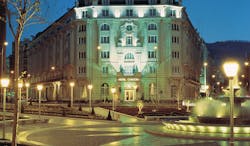
The opulent five star Hotel Carlton is one of the best luxury city hotels in Bilbao, and captures the artistic heritage of such a cultural city. This grand hotel is perfectly situated to explore the wonders of the city.
Standard room
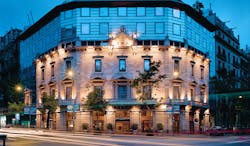
Hotel Claris is unique, 5-star hotel in the centre of Barcelona. Excellent cuisine, superb spa facilities and an excellent rooftop terrace with panoramic city views make this the ideal spot to recuperate after enjoying the city.
Standard room

Hotel Urban is a 5-star boutique art hotel in an excellent central location. A Michelin-starred restaurant and wonderful rooftop terrace with swimming pool provides the perfect space to relax after a day spent exploring Madrid.
Standard room
It has been a lovely holiday & once again, you did not disappoint. Thank you again for everything. We look forward to contacting you again for our next adventure.Mrs H, July 2025
Holiday price guide Prices from £2,640 per person based on two people sharing a double or twin room.
Holiday Code SNFR07
Call us on 01392 441245
Luxury touring holiday of Spain exploring Spanish art and architecture in the three cultural cities of Madrid, Bilbao and Barcelona
About Barcelona
An Expressions tailor-made holiday to Barcelona include the very best four and five star hotels in the city, all of which provide a superb base for a short city break or as the starting point for your holiday to Catalonia. First founded by the Romans, Barcelona is now a dynamic and cosmopolitan city on the Mediterranean coast which is charming and exciting all at once. The capital of Catalonia is famed for its staggering concentration of Gothic architecture as well as surreal wonders such as the Sagrada Familia, making it one of the most visited cities in Europe. Previously a relatively overlooked industrial city, Spain’s second city played host to the Olympic Games in 1992, prompting a period of extensive regeneration and leading to its reinvention as a lively holiday destination. Unique architecture, a rich culture with art galleries and museums abound, gourmet restaurants, lively bars, designer boutiques, golden beaches, parks and gardens – Barcelona has it all. An exhilarating destination for a city break, with much more to discover...
Highlights of Barcelona
There are a huge number of day trips and excursions which those on holiday in Barcelona can enjoy. These include: The Monastery of Montserrat, a religious complex in a spectacular setting atop craggy mountains with chapels, hermits’ caves and numerous nature trails, reached by a one hour train journey followed by an exhilarating cable-car ride; Wineries in towns such as Sant Sadurní d’Anoia and Vilafranca del Penedès, both around one hour away by train; Catalan towns and cities including Tarragona (a port city with fascinating Roman remains), Girona (an ancient walled city with a fascinating history), Vic (a quintessentially Catalan town with an outstanding market) and Figueres (home to the renowned Dalí Theatre-Museum), all of which can be easily reached by train or bus.
Cultural highlights of Barcelona
There are numerous places of interest that visitors should see during their luxury holiday in Barcelona: La Rambla, Spain’s most famous street which is busy at almost any time of the day or night with flower stalls, tarot readers, musicians and mime artists lining the wide walkway which is shaded by trees. The Gothic quarter, a maze of narrow streets and plazas in the old town with architecture dating back to the 14th and 15th centuries. This historic area is home to Catalonia’s government building, the town hall, a former royal palace and the imposing and intricately-decorated La Seu Cathedral, which includes a beautiful cloister. Montjuic, a fortress-topped hill in the south of the city with museums, art galleries and restaurants dotted throughout the spacious gardens. This is also the setting of the 1992 Olympic stadium, the large open space enjoys panoramic views of the city and sea, and is accessible by cable car from the port, by funicular from the base of the hill, by bus or on foot. The harbour area, where almost 3 miles of sandy beaches meet the Olympic port and the older area of Barceloneta, known for its numerous fish restaurants. Parc de la Ciutatella, a popular park with gardens, a boating lake, a zoo, several museums and the striking Catalan Parliament building. Eixample District, a vast area towards the north of the city which was built according to a grid system and is full of unique buildings which were designed in a ‘Modernista’ (Catalan Art Nouveau) style by the famous Antoni Gaudí and his contemporaries. The most famous building which was designed by Gaudí is the Sagrada Familia, an unconventional church building which is filled with symbolism but is still unfinished. Other famous works of art which feature Gaudí’s trademark curved lines, decorated chimneys, elaborate wrought iron and mosaic decorations include Parc Guell, a colourful park which is a UNESCO World Heritage Site; Casa Batlió, a house with a fascinating interior and exterior and La Pedrera, a curved apartment building.
Gastronomy in Barcelona
Cuisine in Barcelona is similar to the rest of Catalonia, taking inspiration from both nearby France and from central Spain whilst making use of local ingredients available including seafood, fresh vegetables, meat and game. Typical dishes include ‘Crema Catalana’ (a Catalan version of a Crème Brûlée), ‘Pa amb tomàquet’ (bread smeared with tomato, oil and garlic), ‘Fideuá’ (a variant of Paella which uses pasta in place of rice), ‘Zarzuela’ (a seafood stew which is made with fish, prawns, squid and mussels), ‘Escudella’ (a stew containing vegetables, meat, rice and pasta) and unusual ‘sea and mountain’ combinations which use both meat and seafood. Barcelona is home to some of Spain’s best restaurants, with gastronomic chefs creating innovative cuisine and over 20 boasting at least one Michelin star. The best fish and seafood can be found in restaurants in the Barceloneta district, or if you want to buy some local produce yourself then head to the busy La Boqueria market on La Rambla.
Climate in Barcelona
Late spring and early autumn are the best times to go on holiday to Barcelona, as the weather is warm with temperatures of around 20 degrees centigrade. Summer is often unbearably hot with some shops and restaurants closing in August as locals leave the city to get away from the heat. Winter is mild with occasional rain and average temperatures of 10 degrees but is an enjoyable time to visit as Christmas markets are held and many celebrations take place.
Call us on 01392 441245
Luxury touring holiday of Spain exploring Spanish art and architecture in the three cultural cities of Madrid, Bilbao and Barcelona
About Green Spain
Green Spain features some of the best four and five star hotels in the regions of Galicia, Asturias and Cantabria in northern Spain, including coastal properties, city hotels and rural retreats. From the pretty rivers on the west coast of Galicia to the spectacular mountains of Asturias and the prehistoric caves of Cantabria, Green Spain is a picturesque area in the north of Spain. With quiet sandy beaches, green landscapes, charming villages and Romanesque architecture lining the famed pilgrimage route which leads to Santiago de Compostela, there is plenty to discover. Although many of those who go on holiday to northern Spain simply pass through en route to Santiago de Compostela, the entire region has much to offer. Stunning beaches are almost untouched, whilst the mild climate has produced rich vegetation which covers unspoilt countryside. Both along the coast and further inland there are attractive cities, towns and villages with a wealth of historical, architectural and cultural sights to discover. Galicia and Asturias have strong cultural identities, both fiercely defending their Celtic traditions which include playing bagpipes, and even speaking their own languages. In the far west is the remote region of Galicia, known as ‘The land of a thousand rivers’ thanks to the numerous wide inlets that run into the sea. The Atlantic coastline is rugged, with rocky headlands, idyllic beaches and isolated fishing villages, whilst the interior is hilly and overwhelmingly green. To the east is the Principality of Asturias, an enchanting region of contrasts with secluded beaches as well as peaceful countryside. Forming a natural barrier in the south are the towering Picos de Europa mountains, a spectacular area with small mountain villages, lush pastures, emerald forests, sheer gorges and glittering lakes. Next is the small, mountainous region of Cantabria, where white sand beaches line the coastline facing the Bay of Biscay, separated by rugged headlands.
Highlights of Green Spain
Santiago de Compostela cathedral, the supposed resting place of St James the Apostle, from whose rooftop you can enjoy unforgettable views over the old town. The attractive Galician cities of Ourense, Pontevedra and Lugo, all with historical sites including Roman architecture. Maritime cities along the Atlantic coastline including A Coruna, Ferrol, Vigo, and Baiona. The Tower of Hercules, an ancient Roman lighthouse near A Coruna. Galicia's fjord-like inlets known as the Rías Altas (along the north-west coast) and the Rías Baixas (along the southwestern coast). The dramatic Cape Finisterre, so called because it was thought to be the westernmost point in Europe. The stunning Picos de Europa mountains, home to a diverse range of walking trails and the atmospheric Covadonga Sanctuary. Oviedo, the attractive capital of Asturias which is home to some remarkable pre-Romanesque churches. Altamira Caves, a UNESCO World Heritage Site with ancient rock paintings which are up to 20000 years old. Comillas, a beachside town with impressive architecture including a building designed by Antonio Gaudí. Pleasant towns along the shores of the Cantabrian Sea including Gijón and Llanes. Santillana del Mar, a picturesque village inland with a number of well-preserved mediaeval buildings. Santander, a lively port city with a historic quarter, a modern centre and the famous El Sardinero beach.
Festivals in Green Spain
February/March: Carnivals celebrating Lent, March: Vigo Reconquest Festival; March/April: Holy week celebrations, July: ‘A Rapa das Bestas’ horse festival held in Galician villages, July: Saint James the Apostle festival in Santiago de Compostela, July: Nava Cider Festival (near Oviedo), August: Festival of San Roque in Betanzos (near A Coruna), August: Santander International Festival.
Gastronomy in Green Spain
Cuisine in the north of Spain tends to be simple and hearty, making good use of the excellent local produce including abundant fish and seafood, plentiful meat and game and a great variety of vegetables. The regions produce a range of dairy products, from the mild soft cheeses of Galicia to the smoked cheese of Cantabria and the blue cheeses of Asturias. Asturias is known for its dry cider, whilst Galicia produces high quality wines, both crisp whites and fruity reds, as well as a strong liqueur, ‘Orujo.’ Local dishes include ‘Vieras de Santiago’ (Scallops, the symbol of St James, which are baked in their shells), ‘Empanada gallega’ (a Galician meat pasty), ‘Lacón con grelos’ (pork shoulder with chorizo, turnips and potatoes), ‘Caldo gallego’ (thick soup with meat, potatoes and beans), ‘Fabada’ (an Asturian stew with pork and beans), ‘Tarta de Santiago’ (an almond cake), ‘La quesada’ (a Cantabrian cheesecake) and ‘Sobaos Pasiegos’ (Cantabrian sponge cakes).
Climate in Green Spain
Green Spain has a wet and mild climate with warm summers and cool winters. Summer is a popular time to visit northern Spain as the weather is sunny yet comfortable, but you can expect good weather in Spring and Autumn as well. Rain falls throughout the year although there is little during the summer months. Temperatures are rarely extreme, although mountainous areas can be very cold in winter with snow falling.
Call us on 01392 441245
Luxury touring holiday of Spain exploring Spanish art and architecture in the three cultural cities of Madrid, Bilbao and Barcelona
About Madrid
An Expressions tailor-made holiday to Madrid is a chance to explore this lively and passionate capital city with a laid-back lifestyle. Atmospheric cobbled streets link bustling squares which are filled with pavement cafes, whilst tree-lined boulevards are overlooked by neo-classical buildings. Our luxury holidays to Madrid feature some of the best four- and five-star hotels in the city, including elegant hotels and more boutique properties. Visitors to Madrid will find plenty to fill their days. Art and culture play an important role, primarily thanks to the three world-class art museums which make up Madrid’s Golden Triangle of Art, home to works by Pablo Picasso, Salvador Dalí and Francisco de Goya. Illustrating the city’s rich history are the sights of Old Madrid, including the lavish Royal Palace, the grand Plaza Mayor, and the city’s spiritual centre – Puerta del Sol. There are plenty of designer shops to browse throughout the city, as well as small boutiques and flea markets which visitors might stumble across. It is after dark that Madrid really comes alive as the streets, parks and open-air cafes fill with people of all ages and the bars and clubs remain open until dawn. What better way to recover from a late night than to while away a morning in the Parque del Retiro, strolling through the beautiful gardens and perhaps hiring a rowing boat on the park’s tranquil lake. For those who wish to escape the energetic city, a number of towns are located nearby which make for an interesting day trip.
Highlights of Madrid
Numerous squares including the historic Plaza Mayor, the setting of bullfights and executions during the Spanish Inquisition. The Royal Palace, a lavish building which was constructed in the 1700s and is still used today for state occasions. The Prado Museum, one of the largest art galleries in the world which contains an impressive selection of Spanish paintings including works by Goya and El Greco. Reina Sofia Museum, displaying modern works including Picasso’s ‘Guernica’. Thyssen-Bornemisza Museum, based on a private art collection which illustrates the history of western art and includes pieces by Goya, Degas and Renoir. Retiro Park formerly used by the royal family and now a popular spot for relaxation. The Teatro Real, an important opera house with performances of opera and dance. Almudena Cathedral. Gran Vía, a famous street which is lined by theatres and shops. Debod Temple, an ancient Egyptian temple which was rebuilt in Madrid in the 1960s. The Santiago Bernabéu Football stadium, home to Real Madrid. El Rastro Market, an open-air flea market which is held on Sundays. Ventas Bullring where bullfights take place every week during the bullfighting season.

